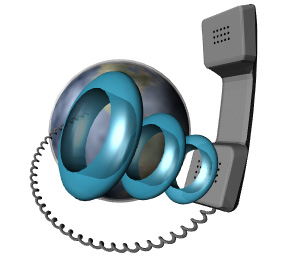The evolution of business telephone lines has been remarkable, from analog landlines to digital T1 CAS trunks, ISDN PRI, and finally SIP packet-based networks. Interestingly, all these technologies are still in use. Let’s examine the two most common configurations for multi-line PBX business phone systems.
 ISDN PRI (Primary Rate Interface)
ISDN PRI (Primary Rate Interface)
ISDN PRI, often shortened to PRI or ISDN PRI, stands for Integrated Services Digital Network Primary Rate Interface.
This standard telecom service is based on the earlier T1 line specification. Initially, T1 aimed to consolidate 24 twisted wire phone lines into 2 pairs, reducing long-distance cabling costs and telephone pole congestion. This was achieved through digital multiplexing, combining 24 channels into a single 1.5 Mbps digital signal, which also minimized noise and crosstalk on long-distance calls.
T1’s advantage lies in its compatibility with existing phone company infrastructure, including landlines and microwave relays. Regenerative repeaters were added to counteract the signal degradation of high-frequency digital signals over long distances, allowing T1 to reach most customers using traditional analog lines.
However, if all 24 channels of a T1 line were used solely for audio, separate wiring would be needed for signaling. The solution was to integrate signal bits into the data stream by slightly compromising the audio quality of each channel, creating the self-contained T1 CAS (Channel Associated Signaling) system.
As phone companies introduced features like caller ID, businesses, especially call centers, sought ways to utilize them. PRI addressed this need by adopting the T1 line structure but dedicating one of the 24 channels for signaling, data, and other background services, leaving 23 channels for individual phone lines.
Modern PBX systems often feature interface cards for direct ISDN PRI cable connection, providing 23 phone lines or more with additional PRIs.
Secondary Rate Interface (BRI)?
While a Secondary Rate Interface doesn’t exist, a related standard called BRI, or Basic Rate Interface, does. Envisioned as a two-phone line system or a higher-speed dial-up modem service, BRI’s popularity waned with the rise of broadband. While favored for radio broadcasting and remote announcing due to its high-quality audio, BRI has largely been replaced by broadband internet.
SIP: A Comparison with PRI
SIP, or Session Initiation Protocol, is a technological rival to PRI, enabling VoIP (Voice over Internet Protocol) phone calls over networks shared with other computing devices.
Unlike the channel-based protocol of ISDN and T1, which dedicates a complete voice channel to a call for its duration, SIP is packet-based. VoIP breaks down conversations into small packets routed through the network. This allows for multiple simultaneous conversations, file transfers, and other digital activities, optimizing network resource usage.
However, this efficiency comes at a cost. Network congestion can occur if demand exceeds capacity, leading to delays and packet loss, ultimately affecting call quality.
Network Considerations for SIP
Careful network engineering is crucial for SIP to ensure timely and accurate voice packet transmission. Prioritizing these data streams through Class of Service mechanisms within the network is common practice.
A dedicated network line for SIP, known as a SIP trunk, is comparable to an ISDN PRI line. While any digital line capable of carrying Ethernet packets can function as a SIP trunk, T1 lines, DS3 bandwidth, and Carrier Ethernet services are frequently used. Dedicated SIP trunks prevent interference from other data packets, making them ideal for connecting business and call center PBX systems to service providers. Like PRI, many PBX systems have network interface cards for direct SIP trunk connection.
SIP vs. PRI
Neither protocol is inherently superior; the choice depends on the specific needs and existing infrastructure. Most PBX systems can connect to both SIP and PRI trunks, regardless of whether they use analog or VoIP phones. SIP trunks are particularly advantageous for modern Unified Communications (UC) or Unified Communications as a Service (UCaaS) systems that integrate computers, desk phones, video conferencing, and mobile phones into a single, interoperable network.
Making the Right Choice
The optimal telephone trunk choice aligns seamlessly with your current or desired system at the lowest cost for the required performance level. Given the significant price drops in both PRI and SIP technologies recently, exploring the available telephone trunk line options for your business needs is highly recommended.

